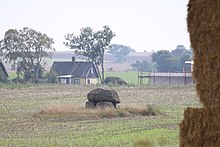Troll loads
The Dolmen Trollasten ( Swedish Trollasten Dös ) is located near Stora Köpinge in the municipality of Ystad in southeastern Skåne in Sweden . The polygonal pole consists of five large and one small bearing stone, which form the polygonal chamber measuring around 2.0 × 2.4 m inside. It is covered by the nearly round, 1.4 m thick capstone with a diameter of about three meters and about 40 bowls .
The north-south oriented troll load (pronounced trollast - from troll ) has been used or re- used at different times . On the stone bottom layer was a layer of sand that contained rotten skeletal parts of a person, as well as some blades, flint chips and about 30 rectangular or ax-shaped and club-shaped amber beads of a type that is often found in passage graves . On top was a layer of sand about 50 cm thick, later disturbed, with late Neolithic utensils: a leaf-shaped arrowhead and shards of pottery from the boat-ax culture . Some pearlsand ceramics date from the Viking Age (800–1050 AD).
The stone wrap
A rectangular stone packing was found on the east side of the chamber, which was probably built around the dolmen. Märta Strömberg , who excavated both facilities between 1965 and 1968, found such a 2.0 × 1.2 m stone packing also at the facilities "Hagestad No. 2" and "Ramshög". Strömberg calls them "VIII: Rectangular stone structures at Ramshög and Hagestad No. 2" and found signs of post construction (or the holes in posts) and human remains mixed with flint fragments. In connection with the stone packing of the Trollasten, there were fragments of funnel beakers from phase C of the early Neolithic.
The pile of broken glass
Outside the stone setting, a flat stone mound about 12 m long and 5.5 m wide was uncovered, which contained about 6000 Middle Neolithic pottery shards that came from different cups. Shattered pottery, which was probably destroyed in connection with religious ceremonies, has been observed in some Skåne passage graves, including Gillhög (18,000 pieces). The cairn also contained about 800 tool fragments and debris of flint and rock. In addition to the scattered finds, clusters of burnt bones, probably human, as well as flint axes and other flint tools came out at about ten different places on the hill. The axes are of the thin-leaf type from the late Middle Neolithic. On the Neolithic pottery shards that were found in and in front of the dolmen, about 50 grain imprints of the wheat types einkorn and emmer could be identified and determined (86%). In addition, there are grains of naked barley . The results agree with the knowledge of grain cultivation during the younger Stone Age in Denmark and southern Sweden.
See also
literature
- Märta Strömberg, Hakon Hjelmqvist: The Dolmen Trollasten in St. Köpinge, Skåne. Rudolf Habelt Verlag, Bonn 1968.
- Karsten Kjer Michaelsen: Politics bog om Danmarks oldtid . Copenhagen 2002 ISBN 87-567-6458-8 , p. 254.
Individual evidence
- ↑ Märta Strömberg: The megalithic tombs of Hagestad. On the problem of grave structures and grave rites . Acta Archaeologica Lundensia Volume 8. Bonn and Lund 1971, p. 339ff
Web links
- Trollasten - entry in the database "Fornsök" of the Riksantikvarieämbetet (Swedish)
- Description and pictures (English)
Coordinates: 55 ° 27 ′ 55.5 ″ N , 13 ° 56 ′ 59.6 ″ E
